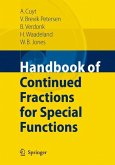This book may be considered as the continuation of the monographs [Tri?]and [Tri?] with the same title. It deals with the theory of function spaces of type s s B and F as it stands at the beginning of this century. These two scales of pq pq spacescovermanywell-knownspacesoffunctionsanddistributionssuchasH¨ older- Zygmundspaces,(fractionalandclassical)Sobolevspaces,BesovspacesandHardy spaces. On the one hand this book is essentially self-contained. On the other hand we concentrate principally on those developments in recent times which are related to the nowadays numerous applications of function spaces to some neighboring areas such as numerics, signal processing and fractal analysis, to mention only a few of them. Chapter 1 in [Tri?] is a self-contained historically-oriented survey of the function spaces considered and their roots up to the beginning of the 1990s entitled How to measure smoothness. Chapter 1 of the present book has the same heading indicating continuity. As far as the history is concerned we will now be very brief, restricting ourselves to the essentials needed to make this book self-contained and readable. We complement [Tri?], Chapter 1, by a few points omitted there. But otherwise we jump to the 1990s, describing more recent developments. Some of them will be treated later on in detail.
"This book can be considered the third volume in an impressive series of books on theory of function spaces...but at the same time it is quite self-contained...The book is...extremely well-written, and reader-friendly, and it contains an enormous amount of deep and interesting material. It is strongly recommended to anybody interested in function spaces or in any of the related areas." -- Mathematical Reviews
"This book is to be considered as the continuation of the author's two monographs ['Theory of function spaces' [and] 'Theory of function spaces. II']; however, it is essentially self-contained and comprehensive...The author's other two monographs have already yielded deep influence to the development of the theory of function spaces. It is reasonable to expect that the present book will also push this field further. It should be extremely useful to graduate students and experts in the fields of fractal analysis, signal processing, numerics, harmonic analysis, PDE, real analysis, approximation theory and functional analysis." -- Zentralblatt MATH
"This book is to be considered as the continuation of the author's two monographs ['Theory of function spaces' [and] 'Theory of function spaces. II']; however, it is essentially self-contained and comprehensive...The author's other two monographs have already yielded deep influence to the development of the theory of function spaces. It is reasonable to expect that the present book will also push this field further. It should be extremely useful to graduate students and experts in the fields of fractal analysis, signal processing, numerics, harmonic analysis, PDE, real analysis, approximation theory and functional analysis." -- Zentralblatt MATH
From the reviews:
"This book can be considered the third volume in an impressive series of books on theory of function spaces...but at the same time it is quite self-contained...The book is...extremely well-written, and reader-friendly, and it contains an enormous amount of deep and interesting material. It is strongly recommended to anybody interested in function spaces or in any of the related areas." -Mathematical Reviews
"This book is to be considered as the continuation of the author's two monographs ['Theory of function spaces' [and] 'Theory of function spaces. II']; however, it is essentially self-contained and comprehensive...The author's other two monographs have already yielded deep influence to the development of the theory of function spaces. It is reasonable to expect that the present book will also push this field further. It should be extremely useful to graduate students and experts in the fields of fractal analysis, signal processing, numerics, harmonic analysis, PDE, real analysis, approximation theory and functional analysis." -Zentralblatt MATH
"This book is the third part in a famous series of books on the theory of function spaces by the same author. ... After an intriguing historical survey in the introductory chapter, the book presents thorough discussions of typical building blocks as non-smooth atoms, quarks, wavelet bases, and wavelet frames. ... The current volume is an impressive and comprehensive account of the state of the art and can to a large extent be read independently ... ." (G. Hörmann, Monatshefte für Mathematik, Vol. 155 (2), October, 2008)
"This book can be considered the third volume in an impressive series of books on theory of function spaces...but at the same time it is quite self-contained...The book is...extremely well-written, and reader-friendly, and it contains an enormous amount of deep and interesting material. It is strongly recommended to anybody interested in function spaces or in any of the related areas." -Mathematical Reviews
"This book is to be considered as the continuation of the author's two monographs ['Theory of function spaces' [and] 'Theory of function spaces. II']; however, it is essentially self-contained and comprehensive...The author's other two monographs have already yielded deep influence to the development of the theory of function spaces. It is reasonable to expect that the present book will also push this field further. It should be extremely useful to graduate students and experts in the fields of fractal analysis, signal processing, numerics, harmonic analysis, PDE, real analysis, approximation theory and functional analysis." -Zentralblatt MATH
"This book is the third part in a famous series of books on the theory of function spaces by the same author. ... After an intriguing historical survey in the introductory chapter, the book presents thorough discussions of typical building blocks as non-smooth atoms, quarks, wavelet bases, and wavelet frames. ... The current volume is an impressive and comprehensive account of the state of the art and can to a large extent be read independently ... ." (G. Hörmann, Monatshefte für Mathematik, Vol. 155 (2), October, 2008)








